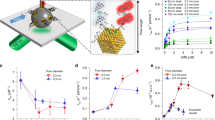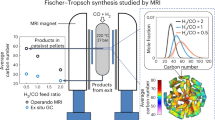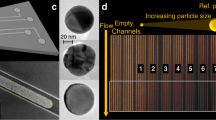Abstract
The performances of porous materials are closely related to the accessibility and interconnectivity of their porous domains. Visualizing pore architecture and its role on functionality—for example, mass transport—has been a challenge so far, and traditional bulk and often non-visual pore measurements have to suffice in most cases. Here, we present an integrated, facile fluorescence microscopy approach to visualize the pore accessibility and interconnectivity of industrial-grade catalyst bodies, and link it unequivocally with their catalytic performance. Fluorescent nanoprobes of various sizes were imaged and correlated with the molecular transport of fluorescent molecules formed during a separate catalytic reaction. A direct visual relationship between the pore architecture—which depends on the pore sizes and interconnectivity of the material selected—and molecular transport was established. This approach can be applied to other porous materials, and the insight gained may prove useful in the design of more efficient heterogeneous catalysts.
This is a preview of subscription content, access via your institution
Access options
Access Nature and 54 other Nature Portfolio journals
Get Nature+, our best-value online-access subscription
$29.99 / 30 days
cancel any time
Subscribe to this journal
Receive 12 print issues and online access
$259.00 per year
only $21.58 per issue
Buy this article
- Purchase on Springer Link
- Instant access to full article PDF
Prices may be subject to local taxes which are calculated during checkout




Similar content being viewed by others
Data availability
All data supporting the findings of this study are available within the Article and its Supplementary Information, and/or from the corresponding authors upon reasonable request.
References
Zaworotko, M. J. Materials science: designer pores made easy. Nature 451, 410–411 (2008).
Davis, M. E. Ordered porous materials for emerging applications. Nature 417, 813–821 (2002).
Kitagawa, S. Porous materials and the age of gas. Angew. Chem. Int. Ed. 54, 10686–10687 (2015).
Serrano, D. P., Escola, J. M. & Pizarro, P. Synthesis strategies in the search for hierarchical zeolites. Chem. Soc. Rev. 42, 4004–4035 (2013).
Cejka, J., Centi, G., Perez-Pariente, J., Roth, W. J. & Heyrovsk, J. Zeolite-based materials for novel catalytic applications: opportunities, perspectives and open problems. Catal. Today 179, 2–15 (2011).
Parlett, C. M. A., Wilson, K. & Lee, A. F. Hierarchical porous materials: catalytic applications. Chem. Soc. Rev. 42, 3876–3893 (2013).
Jones, A. C. et al. The correlation of pore morphology, interconnectivity and physical properties of 3D ceramic scaffolds with bone ingrowth. Biomaterials. 30, 1440–1451 (2009).
Hollister, S. J. Porous scaffold design for tissue engineering. Nat. Mater. 4, 518–524 (2005).
Pagliai, M., Vignozzi, N. & Pellegrini, S. Soil structure and the effect of management practices. Soil Tillage Res. 79, 131–143 (2004).
Nair, B. N. et al. Synthesis of gas and vapor molecular sieving silica membranes and analysis of pore size and connectivity. Langmuir 16, 4558–4562 (2000).
Moghaddam, S. et al. An inorganic–organic proton exchange membrane for fuel cells with a controlled nanoscale pore structure. Nat. Nanotech. 5, 230–236 (2010).
Milina, M., Mitchell, S., Cooke, D., Crivelli, P. & Pérez-Ramírez, J. Impact of pore connectivity on the design of long-lived zeolite catalysts. Angew. Chem. Int. Ed. 54, 1591–1594 (2015).
Du, J. et al. Hierarchically ordered macro- mesoporous TiO2–graphene composite films: improved mass transfer, reduced charge recombination, and their enhanced photocatalytic activities. ACS Nano. 5, 590–596 (2011).
Pérez-Ramírez, J., Christensen, C. H., Egeblad, K., Christensen, C. H. & Groen, J. C. Hierarchical zeolites: enhanced utilisation of microporous crystals in catalysis by advances in materials design. Chem. Soc. Rev. 37, 2530–2542 (2008).
Hartmann, M. Hierarchical zeolites: a proven strategy to combine shape selectivity with efficient mass transport. Angew. Chem. Int. Ed. 43, 5880–5882 (2004).
Christensen, C. H., Johannsen, K., Schmidt, I. & Christensen, C. H. Catalytic benzene alkylation over mesoporous zeolite single crystals: improving activity and selectivity with a new family of porous materials. J. Am. Chem. Soc. 125, 13370–13371 (2003).
Mitchell, S., Michels, N.-L., Kunze, K. & Pérez-Ramírez, J. Visualization of hierarchically structured zeolite bodies from macro to nano length scales. Nat. Chem. 4, 825–831 (2012).
Karwacki, L. et al. Morphology-dependent zeolite intergrowth structures leading to distinct internal and outer-surface molecular diffusion barriers. Nat. Mater. 8, 959–965 (2009).
Fu, D. et al. Nanoscale infrared imaging of zeolites using photoinduced force microscopy. Chem. Commun. 53, 13012–13014 (2017).
Ristanovic, Z., Kubarev, A. V., Hofkens, J., Roeffaers, M. B. J. & Weckhuysen, B. M. Single molecule nanospectroscopy visualizes proton-transfer processes within a zeolite crystal. J. Am. Chem. Soc. 138, 13586–13596 (2016).
Zhu, X. et al. Probing the influence of SSZ-13 zeolite pore hierarchy in methanol-to-olefins catalysis by using nanometer accuracy by stochastic chemical reactions fluorescence microscopy and positron emission profiling. ChemCatChem 9, 3470–3477 (2017).
Whiting, G. T. et al. Binder effects in SiO2- and Al2O3-bound zeolite ZSM-5-based extrudates as studied by microspectroscopy. ChemCatChem 7, 1312–1321 (2015).
Whiting, G. T. et al. Selective staining of Brønsted acidity in zeolite ZSM-5-based catalyst extrudates using thiophene as a probe. Phys. Chem. Chem. Phys. 16, 21531–21542 (2014).
Mitchell, S., Michels, N.-L. & Pérez-Ramírez, J. From powder to technical body: the undervalued science of catalyst scale up. Chem. Soc. Rev. 42, 6094–6112 (2013).
Corma, A., Grande, M., Fornés, V., Cartlidge, S. & Shatlock, M. P. Interaction of zeolite alumina with matrix silica in catalytic cracking catalysts. Appl. Catal. 66, 45–57 (1990).
Corma, A., Martínez, C. & Sauvanaud, L. New materials as FCC active matrix components for maximizing diesel (light cycle oil, LCO) and minimizing its aromatic content. Catal. Today 127, 3–16 (2007).
Corma, A., Grande, M., Fornés, V. & Cartlidge, S. Gas oil cracking at the zeolite–matrix interface. Appl. Catal. 66, 247–255 (1990).
Corma, A., Martı́nez-Triguero, J. & Martı́nez, C. The use of ITQ-7 as a FCC zeolitic additive. J. Catal. 197, 151–159 (2001).
Chen, N.-Y., Liu, M.-C., Yang, S.-C., Sheu, H.-S. & Chang, J.-R. Impacts of binder–zeolite interactions on the structure and surface properties of NaY–SiO2 extrudates. Ind. Eng. Chem. Res. 54, 8456–8468 (2015).
Yan T. Aromatization process and catalyst therefor. US patent 3,843,741A (1974).
Devadas, P., Kinage, A. K. & Choudhary, V. R. Effect of silica binder on acidity, catalytic activity and deactivation due to coking in propane aromatization over H-gallosilicate (MFI). Stud. Surf. Sci. Catal. 113, 425–432 (1998).
Chowdhury, A. D. et al. Electrophilic aromatic substitution over zeolites generates Wheland-type reaction intermediates. Nat. Catal. 1, 23–31 (2018).
Cychosz, K. A., Guillet-Nicolas, R., García-Martínez, J. & Thommes, M. Recent advances in the textural characterization of hierarchically structured nanoporous materials. Chem. Soc. Rev. 46, 389–414 (2017).
Weinberger, C., Vetter, S., Tiemann, M. & Wagner, T. Assessment of the density of (meso)porous materials from standard volumetric physisorption data. Micropor. Mesopor. Mater. 223, 53–57 (2016).
Xu, D., Ma, J., Song, A., Liu, Z. & Li, R. Availability and interconnectivity of pores in mesostructured ZSM-5 zeolites by the adsorption and diffusion of mesitylene. Adsorption 22, 1083–1090 (2016).
Kenvin, J. et al. Quantifying the complex pore architecture of hierarchical faujasite zeolites and the impact on diffusion. Adv. Funct. Mater. 26, 5621–5630 (2016).
da Silva, J. C. et al. Assessment of the 3D pore structure and individual components of preshaped catalyst bodies by X-ray imaging. ChemCatChem 7, 413–416 (2015).
Liu, Y., Meirer, F., Krest, C. M., Webb, S. & Weckhuysen, B. M. Relating structure and composition with accessibility of a single catalyst particle using correlative 3-dimensional micro-spectroscopy. Nat. Commun. 7, 12634 (2016).
Wei, Y., Parmentier, T. E., de Jong, K. P. & Zečević, J. Tailoring and visualizing the pore architecture of hierarchical zeolites. Chem. Soc. Rev. 44, 7234–7261 (2015).
Zou, N. et al. Cooperative communication within and between single nanocrystals. Nat. Chem. 10, 607–614 (2018).
Hendriks, F. C. et al. Single-molecule fluorescence microscopy reveals local diffusion coefficients in the pore network of an individual catalyst particle. J. Am. Chem. Soc. 139, 13632–13635 (2017).
Hendriks, F. C. et al. Integrated transmission electron and single-molecule fluorescence microscopy correlates reactivity with ultrastructure in a single catalyst particle. Angew. Chem. Int. Ed. 57, 257–261 (2018).
Conhaim, R. L. & Rodenkirch, L. A. Estimated functional diameter of alveolar septal microvessels in zone 1. Am. J. Physiol. Heart Circ. Physiol. 271, H996–H1003 (1996).
Madden, C. J., Tupone, D., Cano, G. & Morrison, S. F. α2 Adrenergic receptor-mediated inhibition of thermogenesis. J. Neurosci. 33, 2017–2028 (2013).
Soeller, C., Crossman, D., Gilbert, R. & Cannell, M. B. Analysis of ryanodine receptor clusters in rat and human cardiac myocytes. Proc. Natl Acad. Sci. USA 104, 14958–14963 (2007).
Popielarski, S. R., Pun, S. H. & Davis, M. E. A nanoparticle-based model delivery system to guide the rational design of gene delivery to the liver. 1. Synthesis and characterization. Bioconjugate Chem. 16, 1063–1070 (2005).
Fredrich, J. T., Menéndez & Wong, T.-F. Imaging the pore structure of geomaterials. Science 268, 276–279 (1996).
Mauko, A., Muck, T., Mirtic, B., Mladenovic, A. & Kreft, M. Use of confocal laser scanning microscopy (CLSM) for the characterization of porosity in marble. Mater. Charact. 60, 603–609 (2009).
Wang, W. Imaging the chemical activity of single nanoparticles with optical microscopy. Chem. Soc. Rev. 47, 2485–2509 (2018).
Sperinck, S., Raiteri, P., Marks, N. & Wright, K. Dehydroxylation of kaolinite to metakaolin—a molecular dynamics study. J. Mater. Chem. 21, 2118–2125 (2011).
Yarulina, I., Chowdhury, A. D., Meirer, F., Weckhuysen, B. M. & Gascon, J. Recent trends and fundamental insights in the methanol-to-hydrocarbons process. Nat. Catal. 1, 398–411 (2018).
Keil, F. J. Methanol-to-hydrocarbons: process technology. Micropor. Mesopor. Mater. 29, 49–66 (1999).
Buurmans, I. L. C. et al. Catalytic activity in individual cracking catalyst particles imaged throughout different life stages by selective staining. Nat. Chem. 3, 862–867 (2011).
Qian, Q. et al. Single-particle spectroscopy on large SAPO-34 crystals at work: methanol-to-olefin versus ethanol-to-olefin processes. Chem. Eur. J. 19, 11204–11215 (2013).
Palumbo, L. et al. Conversion of methanol to hydrocarbons: spectroscopic characterization of carbonaceous species formed over H-ZSM-5. J. Phys. Chem. C 112, 9710–9716 (2008).
Van Speybroeck, V. et al. Mechanistic studies on chabazite-type methanol-to-olefin catalysts: Insights from time-resolved UV/vis microspectroscopy combined with theoretical simulations. ChemCatChem 5, 173–184 (2013).
Mores, D., Kornatowski, J., Olsbye, U. & Weckhuysen, B. M. Coke formation during the methanol-to-olefin conversion: in situ microspectroscopy on individual H-ZSM-5 crystals with different Brønsted acidity. Chem. Eur. J. 17, 2874–2884 (2011).
de Winter, D. A. M., Meirer, F. & Weckhuysen, B. M. FIB–SEM tomography probes the mesoscale pore space of an individual catalytic cracking particle. ACS Catal. 6, 3158–3167 (2016).
Acknowledgements
The authors thank M. Rivera Torrente (Utrecht University, UU), I. Beurroies and M. V. Coulet (Aix-Marseille University) for Hg porosimetry data analysis, as well as R. Dalebout (UU) for Ar physisorption measurements. M. de Winter (UU) is thanked for his contribution to FIB–SEM measurements. F. Meirer (UU) and M. Vesely (UU) are also thanked for valuable discussions. This work was funded by a Netherlands Organisation for Scientific Research (NWO) Veni grant, awarded to G.T.W. (no. 722.015.003), a Marie Skłodowska-Curie grant agreement (no. 704544) (to A.D.C.) and a NWO Gravitation program (Netherlands Center for Multiscale Catalytic Energy Conversion, MCEC; to B.M.W.).
Author information
Authors and Affiliations
Contributions
G.T.W., N.N., I.N. and A.D.C. contributed to the preparation, characterization and testing of samples. G.T.W. and B.M.W. designed and directed the project. All authors discussed the results and commented on the manuscript.
Corresponding authors
Ethics declarations
Competing interests
The authors declare no competing interests.
Additional information
Publisher’s note: Springer Nature remains neutral with regard to jurisdictional claims in published maps and institutional affiliations.
Supplementary information
Supplementary Information
Supplementary Data, Supplementary Methods, Statistical Analysis
Rights and permissions
About this article
Cite this article
Whiting, G.T., Nikolopoulos, N., Nikolopoulos, I. et al. Visualizing pore architecture and molecular transport boundaries in catalyst bodies with fluorescent nanoprobes. Nature Chem 11, 23–31 (2019). https://doi.org/10.1038/s41557-018-0163-z
Received:
Accepted:
Published:
Issue Date:
DOI: https://doi.org/10.1038/s41557-018-0163-z
This article is cited by
-
Direct probing of single-molecule chemiluminescent reaction dynamics under catalytic conditions in solution
Nature Communications (2023)
-
Preparation and quantitative analysis of multicenter luminescence materials for sensing function
Nature Protocols (2023)
-
Stabilizing the framework of SAPO-34 zeolite toward long-term methanol-to-olefins conversion
Nature Communications (2021)
-
Directed transforming of coke to active intermediates in methanol-to-olefins catalyst to boost light olefins selectivity
Nature Communications (2021)
-
Implications of Biomolecular Corona for Molecular Imaging
Molecular Imaging and Biology (2021)



